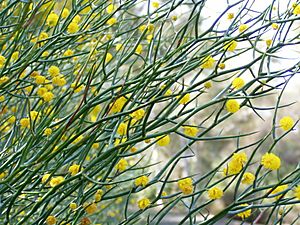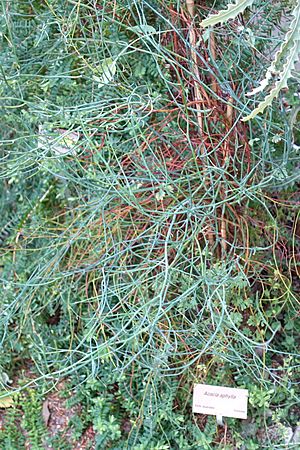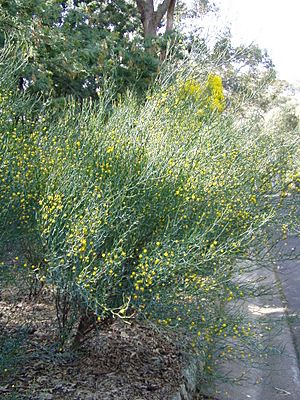Leafless rock wattle facts for kids
Quick facts for kids Leafless rock wattle |
|
|---|---|
 |
|
| Conservation status | |
| Scientific classification | |
| Genus: |
Acacia
|
| Species: |
aemula
|
 |
|
| Where this plant grows (from AVH) | |

The Acacia aphylla, often called the leafless rock wattle, twisted desert wattle, or live wire, is a special type of Acacia plant. It only grows in a specific area around Perth in Western Australia.
Contents
What Makes the Leafless Rock Wattle Special?
The leafless rock wattle is a spiky shrub that grows upright and has many branches. It can reach about 0.9 to 3 meters (3 to 10 feet) tall and spread out about 2 meters (6.5 feet) wide. Its branches are usually bright green, stiff, and round. They are smooth and have a waxy, bluish-green coating. They also feel prickly.
Unlike most Acacia plants, the leafless rock wattle doesn't have true leaves. Instead, its thick, blue-green, wire-like stems do the job of leaves. These stems can perform photosynthesis, which is how plants make their own food using sunlight. This special adaptation helps the plant save water because it has less surface area for water to escape.
Flowers and Seeds
This plant produces bright yellow, round flowers. You can see them between August and October, which is late winter to mid-spring in its native home. Each flower cluster has 20 to 30 small, golden flowers.
Later, the plant forms long, thin seed-pods. These pods are about 3 to 9 centimeters (1 to 3.5 inches) long and 3 to 4 millimeters (0.1 to 0.15 inches) wide. Inside, they hold black, oblong seeds, each about 4 millimeters (0.15 inches) long. The pods are ready to release their seeds from December to March.
When there's a fire, most of these plants die. However, new plants can grow from the seeds that are stored safely in the soil.
Where Does the Leafless Rock Wattle Grow?
This shrub has a very limited range. It is only found in two areas within the Darling Range in Western Australia. These two spots are about 60 kilometers (37 miles) apart. Both areas are east of Perth. One population is in the Hidden Valley area near the Helena River, and the other is south of Northam in the Clackline Nature Reserve.
The government keeps the exact locations of these plants a secret to help protect them.
Its Home Environment
The leafless rock wattle usually grows in open forests. These forests are often filled with large trees like Eucalyptus marginata and Eucalyptus calophylla. It can also be found in woodlands where Eucalyptus loxophleba is common.
Other plants often found nearby include Grevillea endlicheriana, Hakea petiolaris, and Xanthorrhoea preissii. This wattle prefers areas with laterite and granite rocks on hillsides. It can even grow in cracks in the rocks. It grows best in sandy, loamy, clay, or gravelly soils that are brown or yellow.
Growing the Leafless Rock Wattle
People sometimes grow the leafless rock wattle as a decorative plant because of its unique look. Even though it's adapted to tough conditions, it grows quickly. It needs soil that drains well and can handle full sun.
You can prune this plant after it flowers. It can be cut back quite a lot, even down to about 30 centimeters (12 inches) from the ground. New growth will appear in a couple of months.
This plant can handle both drought (very dry conditions) and frost (freezing temperatures). You can grow it from seeds. It produces many seeds in summer, and these seeds can be stored for many years and still grow. In nature, it doesn't grow back very well, and you might not see many new seedlings.
If you want to grow it from seed, you need to soak the hard black seeds in hot (initially boiled) water for 24 hours. This softens their outer coating and helps them sprout more easily and consistently.
History and Discovery
The leafless rock wattle was first officially described in 1974 by a botanist named Bruce Maslin. He wrote about it in a scientific journal called Nuytsia. The name 'aphylla' comes from Latin and means "without leaves," which perfectly describes this plant because it doesn't have typical leaves.
In 1950, the Acacia aphylla was noted as a rare plant. After 1992, it was listed as a vulnerable plant. This means it became protected under the Endangered Species Protection Act 1992 to help keep it from disappearing.
Images for kids
-
The leafless rock wattle growing in a garden in Stockholm, Sweden
See also
 In Spanish: Acacia aphylla para niños
In Spanish: Acacia aphylla para niños







